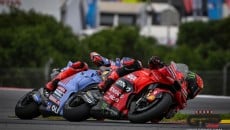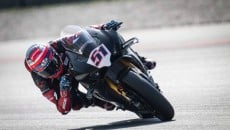What do Nicky Hayden, Casey Stoner and Jorge Lorenzo have in common? Simple, the fact that after the world title they abandoned their iconic 69, 27 and 99 respectively for the # 1 for the championship season.
For modern riders, it’s no small choice because the number, as years and fads go by, has become a distinctive and merchandising element: it is used to sell.
It must be said that for quite a few years the 'race number' element has been exploited far too much: 99% of riders certainly don’t deserve this honour, the sublimation of which, at the end of their careers, is precisely a retirement of the number.
It is also true that another of the distinctive elements of a rider, his helmet, has also been commodified far too much.
If Barry Sheene, in fact, raced virtually his entire career with the # 7 and a helmet with the effigy of Donald Duck, even Valentino Rossi, who has never changed his iconic # 46, modified the design of the helmet, albeit often maintaining the emblematic sun and moon.
For us, the identifying element of the rider has always been the helmet: Giacomo Agostini - # 1 forever - we remember him more for his tricolour helmet, but it is true that in the past the numbers, except for the rare case of Sheene, were assigned based on placement of the ranking of the previous year.
So, don’t the numbers, apart from the sale of caps and t-shirts, no longer count? It’s not true: for manufacturers, boasting the # 1 on the fairing (now only on the front, alas, to offer a cleaner image) is still a source of pride. And it is for this reason that during this winter, strengthened by the double triumph in MotoGP and Superbike, Ducati put gentle pressure on Pecco Bagnaia and Alvaro Bautista to adopt it.
Officially, both played the game on social media and in interviews, postponing the decision until Monday, when the official presentation will take place on the snows of Madonna di Campiglio.
In the meantime, a photo of Bagnaia with the # 1 alongside and with a small # 63 inside, has leaked - appearing and rapidly disappearing - on the Ducati website. Just as Bautista showed himself on social media with both numbers in hand, 1 and 19, which we also remember on the fairings of the first Freddie Spencer.
Fast Freddie raced with the # 4, with the # 1 and with the # 19 he won the 250 title in 1985. In short, it's not the number that makes the champion, but the champion that makes the number. But it is true, however, that for Ducati, showing up with two # 1s graphically represented on the fairings of the two most important championships, prototypes, and production derivatives, has an impressive brand value.
Ah, don't put too much faith in mistakes, in photos 'published' by chance. By now, alas, marketing is everywhere, and the riders are paid well enough, including engagement fee, finish prizes and bonuses in the event of a world title, to temporarily abandon their iconic personal number. Also, because they secretly would like to be represented by that very # 1 that they seem to have so much difficulty accepting.











